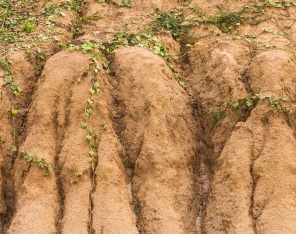
5 Effective Ways To Minimise Soil Erosion Impacts

Soil erosion is the degradation or wearing away of the top layer of soil by wind and water. Although a naturally occurring process, soil erosion is often intensified by human land use practices such as land clearing, overgrazing and soil cultivation.
Lands that have been overgrazed or stripped of vegetation leave the fertile topsoil exposed and vulnerable to soil erosion. This valuable topsoil, which contains most of the soil’s plant nutrients and microorganisms that contribute to soil health, is eroded at a faster rate by wind and water, leaving behind degraded land and subsoil that is less fertile and even more vulnerable to erosion.
Effects of soil erosion
The effects of soil erosion on agriculture, waterways and infrastructure are serious and far-reaching. Crop growth and yield can be directly affected by the loss of the nutrient-rich topsoil, while seeds and plants can be disturbed or completely removed by erosion. Once arable lands can become completely barren and unusable, leading to financial loss and reduction in productivity.
And the effects of soil erosion even go beyond the loss of fertile land. Sediment generated from erosion on building or construction sites can be a major source of pollution to local waterways. Sediment and chemical fertilisers that are washed off the land and into waterways can reduce water quality, cause harm to aquatic plants and animals, and place extra burden on water treatment processes. Roads, bridges and buildings can also be damaged or destroyed by rockfalls, landslides and other mass movements of soil caused by erosion.
Prevent and minimise soil erosion
We’ve put together a list of five practical and effective ways to minimise soil erosion on cropping lands, mine sites and construction sites:
1. Minimise vegetation disturbance
The first step for any construction or mine site should be to identify and preserve natural vegetation to the greatest extent practicable. Protecting trees and other ground cover is the most effective way to protect the fertile topsoil against the erosive action of rain and overland flow.
2. Polymer based products
Polymer based products are typically used for dust suppression, but they also prevent soil erosion. These cost-effective water soluble polymer solutions typically work by penetrating the top layer of the soil and forming a durable layer that binds soil particles into a solidified medium to hold them on site.
3. Geotextiles
Geotextiles are permeable fabrics that can be used to stabilise loose soil, filter sediment out of water and minimise erosion from wind and water. Made from woven, non-woven or knitted fabrics, these biodegradable or semi-permanent mats have the ability to filter, reinforce, protect and drain the precious soils and vegetation they protect.
4. GeoSpray
GeoSpray is a cost-effective and environmentally-friendly spray on erosion control blanket that is ideal for stabilising road side batters, swale drains, sedimentation control and mining applications. The blend of minerals, interlocking fibres and binding agents can be applied within minutes to steep or inaccessible slopes using hydroseeding equipment. GeoSpray dries quickly to form a unique flexible cover and is able to withstand moderate rain events just 4 hours after application.
5. Hydromulching
Hydromulching is the application of a slurry of seed, fertiliser, fibre-mulch and water onto exposed topsoil to protect the soil from erosion and the seeds from washing away in the rain. Hydraulic Growth Medium (HGM) products are added to the hydromulch mixture to replenish the soil of natural essential organic materials and nutrients and protect the surface from erosion by retaining moisture.
Before attempting these erosion control methods, an appropriate soil analysis and on-site evaluation of drainage channels and slopes should be performed by an expert.





